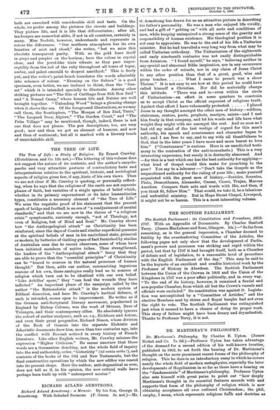TWO ART BOOKS.
Preece. Painted by John Falleylove. Described by the Rev. J. A. McClyinont, D.D. (A. and C. Black. 20s. net.)—The "Description," to speak first of the literary portion of this book, is something of a disappointment. It tells us again, with no particular freshness or distinction, what we have often heard before. Dr. McClymont has written it in his study, with his classical dictionaries, his Grote, and his Pausanias before him. What we should like to have had is, if we may so put it, "Old Greece in tho setting of the New." We have not much to criticise. The ship turned into stone by the angry Poseidon was not "beginning its homeward voyage to Ithaca with Odysseus on beard"; it had taken the hero to Ithaca and so offended the deity, and was then on its homeward voyage. But the description is not interesting. The pictures are highly pleasing ; Mr. Fulleylove is in his element when he is painting such a subject. The atmosphere and everything else suit his genius. Possibly the proportion of the illustrations assigned to Athenian monu- ments, &e., is too preponderating. Considering that many of these are already familiar to all conversant with the subject, we cannot but think that two-thirds is an excessive proportion to be allotted to this one portion of the subject. The islands are, we see, entirely omitted; but they occupy too important a part in Greek history to be so neglected. Some of the main- land States are not nearly so important as Delos, Lesbos, Chios, and Melos.--Algeria and Tunis. Painted and Described by Frances E. Nesbitt. (Same publishers. 20s. net.)—Here, happily, we may compare pictures and letterpress without any fear of being disagreeable. Both come from the same band; whether or no Kiss Nesbitt herself prefers one gift to the other, we may say that
both are exercised with considerable skill and taste. On the whole, we prefer among the pictures the streets and buildings. They picture life, and it is life that differentiates ; after all, landscapes are somewhat alike, if not in all countries, certainly in many. Miss Nesbitt, however, understands and represents in colour the differences. "Our northern atmosphere has its own beauties of mist and cloud," she writes, "but we miss this absolute transparent purity. With us the gold loses itself in greys and purples on the horizon; here the colour in crystal clear, and the jewel-like tints vibrate as they pass imper- ceptibly from the red of the ruby throughout all tones of topaz, amber, and palest emerald to deepest amethyst." This is finely put, and the writer's paint-brush translates the words admirably into schemes of colour. "Evening on the Sahara" is a good specimen, even better, we are inclined to think, than the " Sun- set " which it is intended specially to illustrate. Among other striking pictures are "The Site of Carthage from Sidi Bou Said ". and "A Nomad Camp," where human life and Nature are well brought together. "Unloading Wood" brings a pleasing change when it shows the sea. Of the foreground illustrations, as we may call them, the frontispiece, "The Mosque of Ben Ziad, Tunis," "The Leopard Door, Algiers," "The Garden Court," and "The Palm Village" may be mentioned, though, indeed, there is not one that does not please. The pen descriptions, too, are very good; now and then we get an element of humour, and now and then of sentiment; but all is marked with a literary touch of unmistakable skill:































































 Previous page
Previous page